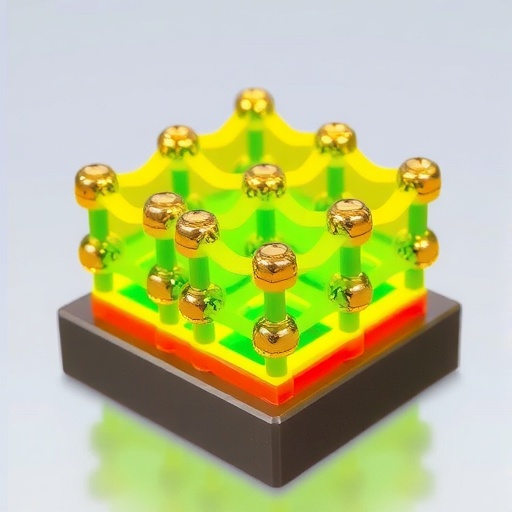In recent years, the growing demand for efficient energy storage solutions has propelled the exploration of innovative materials that can significantly enhance performance. A groundbreaking study conducted by a dynamic team of researchers, including Shehzad M.F., Alotaibi B.M., and Alyousef H.A., focuses on the fabrication of ZnCr₂S₄ and ZnCr₂S₄/rGO (reduced graphene oxide) composites. This study not only addresses the paramount issues of energy storage capacity but also delves into the intricate synthesis processes and the resulting electrical properties, providing a fresh perspective on energy storage systems of the future.
The research, documented in the prestigious journal Ionics, explores the synthesis techniques required to create these ZnCr₂S₄ materials, which hold promise for various applications, particularly in batteries and supercapacitors. ZnCr₂S₄ is a chalcogenide compound that exhibits unique electrical and electrochemical properties due to the synergistic effects of its constituent elements. This study hypothesizes that integrating reduced graphene oxide with ZnCr₂S₄ can further enhance the electrical conductivity, thereby making it a more viable candidate for next-generation energy storage systems.
The scientists meticulously describe the experimental processes that led to the successful fabrication of these materials. By adopting hydrothermal synthesis methods, the researchers were able to create ZnCr₂S₄ nanostructures that display optimal morphology and crystallinity. The choice of this synthesis route is pivotal; it allows for a high level of control over the material characteristics, ultimately influencing their electrochemical performance. The team emphasizes that controlling variables such as temperature and reaction time is essential to achieving the desired properties within the synthesized compounds.
Upon successful synthesis, the study carefully characterizes the produced materials using various techniques. X-ray diffraction (XRD) is employed to evaluate the crystallinity and phase purity of the ZnCr₂S₄ and its composites. Scanning electron microscopy (SEM) provides insights into the surface morphology and particle size, revealing the nanoscale features that are crucial for electrochemical applications. This comprehensive characterization ensures that any claims regarding performance enhancements are backed by robust data, lending credibility to the findings presented in the article.
One of the standout findings of the research is the observation of how the incorporation of rGO affects the electrochemical properties of ZnCr₂S₄. The researchers note that reduced graphene oxide not only increases the electrical conductivity of the composite materials but also enhances the overall surface area available for ion storage. This dual mechanism fosters improved charge and discharge rates, which are critical parameters in applications such as supercapacitors where rapid energy retrieval is necessary.
The implications of these findings extend beyond theoretical curiosity; they hold real-world potential for revolutionizing energy storage technology. As the global community pivots towards renewable energy sources, the demand for efficient, cost-effective, and sustainable energy storage solutions continues to escalate. The performance metrics demonstrated by the ZnCr₂S₄/rGO composites suggest that they could play a pivotal role in the development of batteries and supercapacitors that outperform existing technologies.
Further examination of cycling stability reveals another compelling advantage of these ZnCr₂S₄ materials. The research indicates that the cycling performance of ZnCr₂S₄/rGO composites remains remarkably stable, even after numerous charge-discharge cycles. This long cycle life is a crucial consideration for any material intended for commercial energy storage applications, as it directly correlates with the longevity and reliability of energy systems in practical scenarios.
Another vital aspect discussed in the study is the scalability and feasibility of the synthesis process for mass production. The research team evaluates whether these promising materials can be produced on a larger scale while maintaining cost-effective practices. Given the urgency of transitioning to sustainable energy solutions, their insights regarding the production scalability of ZnCr₂S₄ and its composites positions this research ahead of many conventional energy storage materials that may falter in this regard.
As this research gains traction, it invites further inquiries into the potential of ZnCr₂S₄ and rGO composites in various settings. For instance, possibilities abound for these materials to be integrated into electric vehicles, where rapid charging and discharging capabilities are paramount. Additionally, their application could extend to grid storage solutions, which are essential for balancing energy supply and demand as more renewable sources come online.
The authors invite fellow researchers and industry practitioners to explore the potential applications of ZnCr₂S₄/rGO in conjunction with ongoing advancements in energy storage technologies. They underscore the importance of collaborative efforts in moving beyond traditional energy paradigms to embrace innovative materials that can help address the challenges of energy sustainability for future generations.
In conclusion, the study highlighted in Ionics marks a significant step forward in the understanding and application of ZnCr₂S₄ and rGO in the realm of energy storage. With their extensive research covering synthesis, characterization, and practical implications, the authors pave the way for continued innovation in this vital field. As the global energy landscape transforms, the prospects of these novel materials illustrate the exciting possibilities that lie ahead for energy storage solutions, ultimately enhancing the efficiency and reliability of our transition towards a sustainable future.
Subject of Research: Fabrication of ZnCr₂S₄ and ZnCr₂S₄/rGO for energy storage system
Article Title: Fabrication of ZnCr₂S₄ and ZnCr₂S₄/rGO for energy storage system
Article References: Shehzad, M.F., Alotaibi, B.M., Alyousef, H.A. et al. Fabrication of ZnCr2S4 and ZnCr2S4/rGO for energy storage system. Ionics (2025). https://doi.org/10.1007/s11581-025-06610-9
Image Credits: AI Generated
DOI: https://doi.org/10.1007/s11581-025-06610-9
Keywords: ZnCr₂S₄, rGO, energy storage, supercapacitors, hydrothermal synthesis, electrochemical properties, cycling stability.




